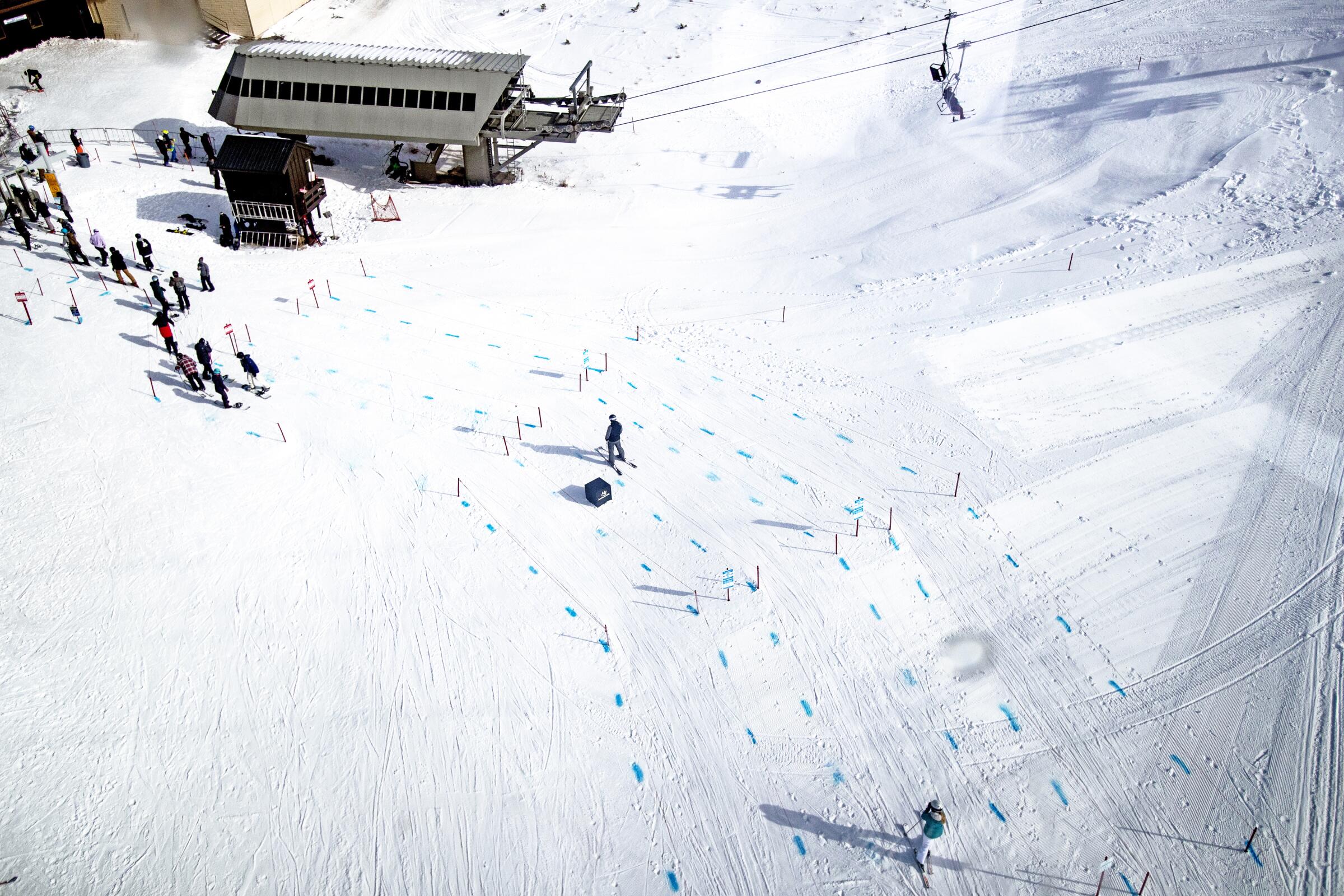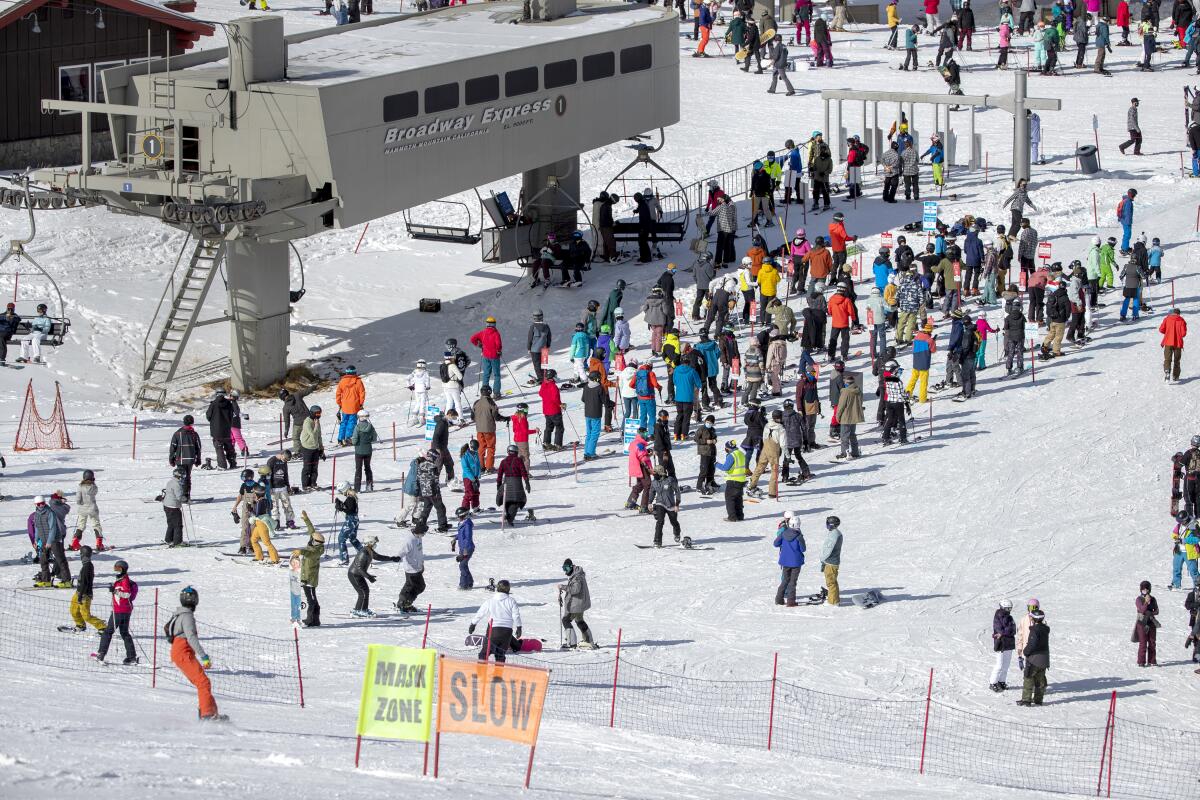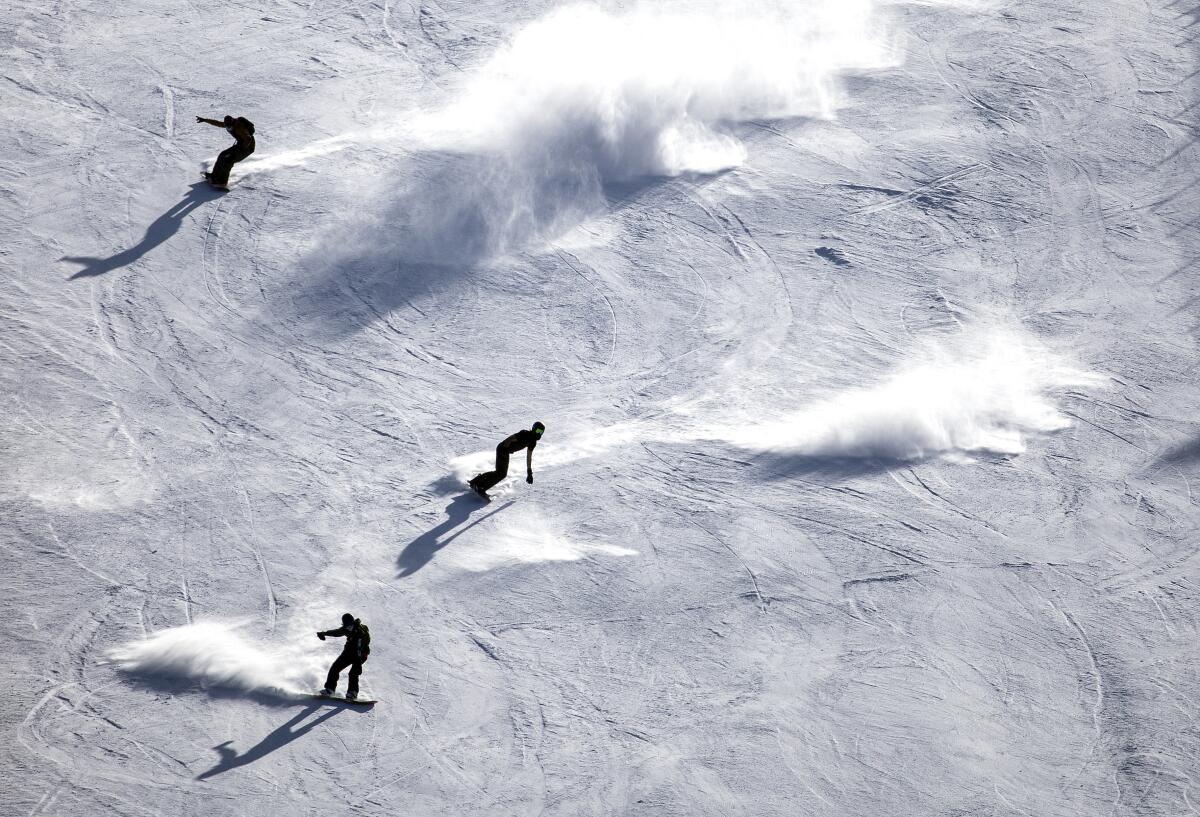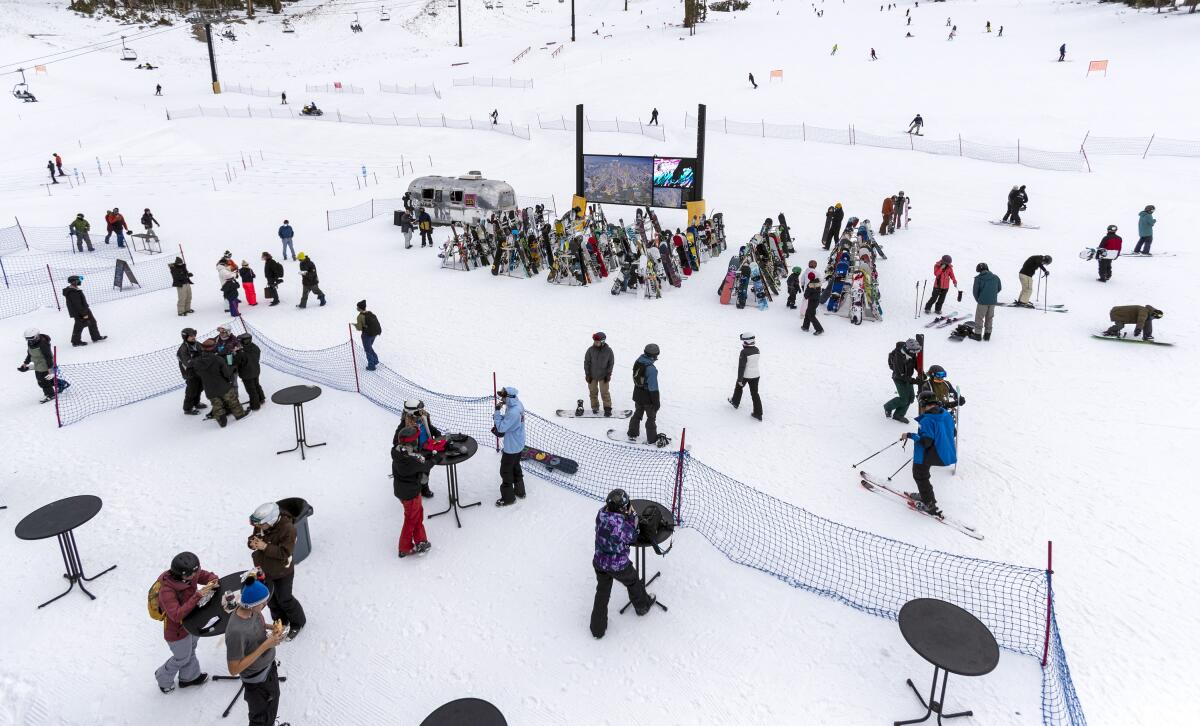Sign up for The Wild
We’ll help you find the best places to hike, bike and run, as well as the perfect silent spots for meditation and yoga.
You may occasionally receive promotional content from the Los Angeles Times.

The joy of skiing and snowboarding comes in snap decisions and fleeting sensations. But to feel that joy this winter, skiers and boarders will need to plan ahead.
That’s because of the many measures that winter resorts have imposed in their scramble to ward off COVID-19 infections. California ski resorts have been cheered by the season’s first big snows, which dropped up to 18 inches in the Sierra on Nov. 7. But experts throughout the West say resorts will be operating at reduced capacity and depending more on advance bookings and guests’ flexibility.
“The biggest thing we’re telling people this year is: Know before you go,” said Chris Linsmayer, public affairs director for Colorado Ski Country, which represents 22 resorts in that state.

There will be more cleaning and disinfecting, of course, and daily temperature checks for most resort employees. There will be distanced lift lines — which, if you’re a skier, means lining up tip to tail. Many resorts are requiring face coverings just about everywhere when you’re not eating or drinking, which, if you already favor bandannas or gaiters, may be an easy adaptation.
That said, every resort is a bit different, just as every county’s and state’s COVID-19 restrictions are a bit different. For instance, in California, face coverings in public indoor spaces are mandatory for children age 2 and older, while in Colorado the mask mandate begins at 12.
Wherever you’re going with your skis or board, pay close attention to the resort’s website — almost all have a section for COVID-19 measures — and its social media feed.
New terrain, lifts, restaurants, programs and air access are debuting. Here’s some of what skiers and boarders will find in California and the West.
Here is how the pandemic is changing things as scores of winter resorts in the West ready for opening.
Prebooking is in, especially for lift tickets. Many places have made it mandatory. In Colorado, said Linsmayer, “Almost of our member [resorts] are requiring prepurchase of lift tickets.” Mammoth Mountain, which opened Nov. 13, is not selling walk-up lift tickets this season. Neither is Deer Valley in Utah nor Vail in Colorado.
As for season passes, resort policies vary widely. For instance, Mammoth Mountain does not require its Ikon Pass holders to make reservations, but Vail Resorts does require its Epic Pass holders to reserve.
One thing that hasn’t changed: If you ski on a weekday, you’ll have emptier slopes.

Expect touchless transactions everywhere. They were already on the rise, thanks to the radio-frequency identification scanning of tickets and passes, and now will become ubiquitous. Lake Tahoe’s Sugar Bowl Resort is among the venues to install RFID lift gates for this season. Many guests at Marriott’s resorts will be able to use their Marriott Bonvoy mobile app to check in and then use their phones as electronic room keys, avoiding the front desk. Many ski-area restaurants will nudge diners to access menus and order by phone.
Ski school will survive. Groups will be smaller, and some locations will accept only advance bookings, with no walk-ups. Also, some resorts may require private lessons for younger children to reduce transmission risk. At most Colorado resorts, Linsmayer said, the limit will be 10 in a class; most classes will be half a day, not all day, to avoid eating together. Many California resorts have similar plans. “You’ll definitely have to plan ahead on lessons a lot more,” said Anelise Bergin, director of communications for Ski Utah.
Welcome to our comprehensive gift guide for the 2020 holiday season.
Equipment rental operations don’t want last-minute business. They too will do their best to avoid last-minute mob scenes. And the nascent 2019 trend of renting ski clothing as well as gear seems to be over, Linsmayer said. Many visitors may spend money on alternatives such as Black Tie Skis, which accepts reservations online or by phone, then delivers sanitized rental equipment to customers at 41 resorts throughout the West, including Mammoth and Lake Tahoe.

Capacities are reduced indoors and on lifts, gondolas and buses. Authorities hope that will cut crowds at resorts’ busiest “pinch points.” Rather than seat strangers next to one another, lift operators probably will keep one seat empty on doubles, middle seats empty on triples, two seats empty on quads and up to three seats empty on six-seaters.
Wyoming’s Jackson Hole Aerial Tram, which usually carries 100 passengers, will be limited to 25 at a time this winter. The Utah Transit Authority, which runs ski buses between Salt Lake City’s airport and many resort areas, has reduced passenger capacity, increased cleaning, added driver barriers and set up a contactless payment system.
Fortunately, said Michael Reitzell, president of the trade group Ski California, “Once you’re actually out on the slopes, there’s very little concern” about distancing. “If you get within six feet of someone when you’re skiing, you’re doing something wrong.”
Takeout meals will multiply and food trucks will boom. Especially at lunchtime. The North Lake Tahoe Resort Assn. has put together a downloadable guide with more than 150 restaurants offering takeout. In Steamboat Springs, Colo., the Taco Beast snow cat food truck, which roams the mountain offering lunches, will be joined soon by a Pizza Ranger. Said Ski California’s Reitzell: “We do have some resorts that are saying, ‘We have no indoor dining at all.’ ”

Outdoor and distanced dining is growing. More dinners will happen in tents, yurts and other hastily adapted structures because dining rooms are roped off. At the River Ranch Lodge in Alpine Meadows near Lake Tahoe, “We’ve got a tent up. It’s going to help us spread out,” said bar manager Christian Rojek
The Denver Post reports that Mountain Village, near Telluride, Colo., has refurbished 20 old gondolas for use as “dining cabins” with lights, heating, ventilation and cushioned seating for six to eight people who can order from a dozen nearby restaurants. Aurum Food & Wine will serve meals in new yurts, which hold up to eight diners each, in Breckenridge and Steamboat Springs, both in Colorado. The general rule of thumb, said Linsmayer, is “outdoor everything.”
More car time, less tailgating. Instead of gearing up in the lodge, you might put your boots on in your car. A few hours later, you might have a brown-bag or takeout lunch there too. Many skiers and boarders will be driving to the slopes and making their vehicles a base of operations to avoid weather, crowds and shuttle buses. Realizing that, some resorts will require reservations for parking. Colorado’s Copper Mountain, to open Monday, is already taking parking bookings.
Get The Wild newsletter.
The essential weekly guide to enjoying the outdoors in Southern California. Insider tips on the best of our beaches, trails, parks, deserts, forests and mountains.
You may occasionally receive promotional content from the Los Angeles Times.
But that doesn’t mean tailgate partying. Resorts are expected to police their lots more closely, and Colorado’s Arapahoe Basin has closed reservations for its popular parking/partying area known as “the beach.” “Please,” the resort says on its website, “do not tailgate or throw parties in our parking lots this season.”
Everything could change. With infection rates rising quickly in most of the U.S., many snow-country states and counties are likely to tighten restrictions, just as many California counties tightened reopening restrictions on Nov. 11 and 16. Many resorts also are likely to adjust their operations once the season is in swing. Skiers and boarders already change their plans hour by hour depending on the physical climate. Now they need to consider the public health climate too.
Sign up for The Wild
We’ll help you find the best places to hike, bike and run, as well as the perfect silent spots for meditation and yoga.
You may occasionally receive promotional content from the Los Angeles Times.